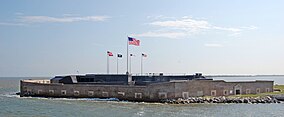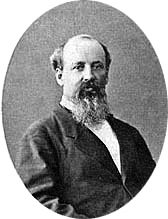4/12/1861 - Choice for today is one of those grand before-and-after moments where nothing is ever the same again, and which in this case, still shadows the world we currently occupy ... apologies if you are already fully aware of the story (I've got a sad feeling most of the citizens of this country aren't though), but today really mattered because in 1861, this was the last day of peace between the North and South, by the time the sun arose on 4/12, America was at war with itself due to the shelling of Fort Sumter in Charleston Harbor.
Bombardment Of Fort Sumter By Currier & Ives
Tensions building for months as Lincoln is elected president, southern states begin seceding from the Union, a Confederate United States government under the direction of President Jefferson Davis of Mississippi is created, and demands are made that Federal locations, like forts and armories be turned over to the states they reside in leads to a grave situation in South Carolina in which neither side is willing to back down or compromise ... the North will not give up Fort Sumter (freshly occupied the day after Christmas, 1860) and has announced plans to send supply ships to keep the site viable (the men at the fort have roughly four days of food left to eat when the shelling begins ... they also welcome news that 200 more soldiers are on the way), while the South gives the fort an ultimatum from Confederate authorities (brought out to the fort by row-boaters Colonel James Chestnut, Colonel James A. Chisholm, and Captain Stephen D. Lee), that if its walls aren't evacuated by 4:20 in the morning of 4/12, the structure will be fired upon.

Chestnut
Picked specifically for his southern roots (and the ability it might provide in dealing with the citizens of Charleston), in command of Fort Sumter is 55-year-old Major Robert Anderson of Louisville, Kentucky (his father is the former aide-de-camp to the Marquis de Lafayette, while his mother is a cousin of John Marshall, the fourth Chief Justice of the Unites States Supreme Court) ... a soldier quite familiar with war. A graduate of West Point's Class of 1825, before the Civil War begins, Anderson will be a colonel of Illinois volunteers during the Black Hawk War of 1832 (assisted by Jefferson Davis, he will transport Black Hawk himself into captivity), will serve on the staff of Brigadier General Winfield Scott during the Second Seminole War, in the Mexican-American War, he participates in the siege of Vera Cruz and the battles of Cerro Gordo, Amazoque, and Molino del Rey. Wounded at Molino del Rey, after the war Anderson is a member of the board of officers that creates "A Complete System of Instruction for Siege, Garrison, Seacoast, and Mountain Artillery" ... and teaches that system to cadets matriculating at West Point Military Academy. And it is a pupil turned comrade and friend that he will be facing in South Carolina (after receiving the last ultimatum, Anderson shakes hands with the men at their boat, and states, "If we never meet in this world again, God grant we may meet in the next.") ... 43-year-old Confederate Brigadier General Pierre Gustave Toutant-Beauregard of St. Bernard Parish, Louisiana.

Major Anderson
The epitome of the Southern Gentleman of the times, Beauregard is born into a French Creole family with roots in Italian nobility ... growing up he attends private schools (he doesn't learn English until he is 12 and living in New York City), attending West Point he graduates second in the Class of 1838, excelling at the use of artillery and in military engineering. Serving as an engineer in the Mexican-American War, Beauregard is in the thick of things at the battles of Contreras, Churubusco, and Chapultepec (his concerns with the plan of attack for storming the fortress cause Scott to change his preparations prior to the assault), where he is wounded in the thigh and shoulder, and he is one of the first United States officers to enter Mexico City. After the war, Beauregard works at repairing old forts and building new ones (his knowledge, the major reason he is sent to Charleston), improves the shipping channels at the mouth of the Mississippi (he will invent and patent a device that allows ships to cross bars of sand and clay), fixes the stability of the sinking U.S. Custom House in New Orleans, campaigns for Franklin Pierce for president during the elections of 1852, runs for the mayor of New Orleans (he loses), and teaches at West Point (briefly, for a matter of only days, he is the Superintendent of the Academy). Upon Louisiana seceding from the Union, Beauregard tenders his resignation from the Unites States Army and enrolls in the "Orleans Guards," a battalion of French Creole aristocrats, as a private (upset the state army has been placed in the hands of West Point rival, Braxton Bragg). A foolish position for one with such an extensive knowledge of military affairs and engineering, he however is soon plucked away by Jefferson Davis, promoted to Brigadier General, and placed in charge of dealing with Fort Sumter.

Beauregard
Begun in 1829 and still not completed by 1861 (90% at the start of the war), the fort is named after Revolutionary War hero, General Thomas Sumter and is created to protect the sea approaches into Charleston Harbor on a sand bar using over 70,000 tons of granite brought south from New England, fashioned into a five-sided, three-story brick structure 170 feet to 190 feet long, with 5 feet thick walls, standing 50 feet above the low tide mark, capable of housing 650 men and 135 guns. At the time it comes under fire, along with Anderson, the fort's complement of men consists of seven other officers (one, is the supposed inventor of baseball, Captain Abner Doubleday), 68 non-commissioned officers and privates, and eight musicians (along with 43 non-combatant workmen) to maintain and operate 60 guns (most facing out to sea) ... of the officers at the fort, five will become generals before the conclusion of the war.
Modern Aerial View

Sumter Layout

Doubleday

Modern View
Challenging the fort, instead of complimenting it as originally had been intended, Beauregard has a series of positions around the harbor that are capable of pounding the structure from every point of the compass. At nearby Fort Moultrie there are three 8-inch Columbiads, two 8-inch howitzers, five 32-pound smoothbores, and four 24-pounders ... outside the fort, there are five 10-inch mortars, two 32-pounders, two 24-pounders, and a 9-inch Dahlgren smoothbore. On a nearby float made of wood and iron, there are two 42-pounders and two 32-pounders. The arsenal of Fort Johnson on James Island consists of one 24-pounder and four 10-inch mortars, and at Cummings Point on Morris Island, the Confederates can fire on Fort Sumter with seven 10-inch mortars, two 42-pounders, an English Blakely rifled cannon, and three 8-inch Columbiads. There are roughly 6,000 soldiers scattered about the harbor in service of Beauregard's field pieces.
Charleston Harbor - April, 1861
Columbiad
Warned, at precisely 4:30 in the morning of 4/12/1861, acting upon the orders of Captain George S. James, Lt. Henry S. Farley fires a shell from a 10-inch mortar at Fort Johnson that explodes over Fort Sumter ... the signal for a general bombardment of the fort, with guns taking turns firing every two minutes in a counter-clockwise motion around the harbor (the firing will last until the fort finally surrenders, 34 hours, and over 3,000 shells, later). Church bells ringing and guns booming, not understanding the forces the attack on Fort Sumter will unleash, citizens of Charleston get out of bed, dress, and make their way to the waterfront where they party, watching the fireworks, as if they are celebrating the arrival of a new year. Less weapons and ammo, Anderson does not respond until daylight, and then, after his men have suffered through a breakfast of salt pork, at 7:00 in the morning, Doubleday fires the first Northern shot of the war at the Confederates firing from Cummings Point ... a miss.
Fort Sumter - 1861
In the hours that follow, huge sections of the fort will be pulverized, wooden structures inside the walls were be burnt to the ground, and the relief expedition of Captain Gustavus V. Fox is forced to turn back. Beyond enduring the cannonade, Northern heroics are supplied by Sgt. John Carmody and Lt. Norman Hall. All men ordered to stay away from the unprotected cannons on the highest, exposed level of the fort, Carmody tires of eating shelling dust and sneaks up to the barbette, and fires, one at a time, all the already loaded weapons facing Fort Moultrie to the northeast, while Hall risks shellfire to save the fort's American flag when it is knocked down by an exploding shell and also helps put it back up on a makeshift flagstaff (and burnt off permanently, loses his eyebrows in the process). Both men will survive their moments of fortitude! Outcome inevitable however, guns available down to six, honor intact by fighting back for two days, on April 14th, Anderson finally surrenders the fort to Beauregard.

Gustavus Fox - 1866
Fort Sumter Ruins
Putting The Flag Back Up!
Putting The Flag Back Up #2
The Fort Sumter Flag
Miraculously, no Union soldiers have been killed in the bombardment (four are wounded by flying bricks and mortar) and the terms of surrender are quite reasonable ... the garrison will be allowed to evacuate the fort after firing off their remaining ammo in a 100-gun salute to their flag, and then will be brought out to the blockaded ships of Fox for transportation home. At 2:00 in the afternoon of April 14th, the salute begins, but is cut short at only 50 guns firing when it proves more deadly than the just ended siege ... ramming a powder cartridge home before sparks from the previous round have been swabbed out of his cannon, Private Daniel Hough has his right arm blown off and dies instantly, and Private Edward Galloway is mortally wounded when that explosion causes other nearby shells to fire off prematurely (four other men will be wounded, but survive).
Death Comes To Fort Sumter
The Confederate Flag Over Fort Sumter
No turning back, in the days that follow the war's first military action, over 75,000 men volunteer to serve in the northern army, and four more southern states vote to secede from the Union ... four years of war that will tear the country apart begins, a struggle that will see over 3,000,000 men in arms, and result in over 705,000 deaths. Bad, bad times that start with the rejection of an ultimatum today!
Firing On Fort Sumter
New York City Rally - The Fort Sumter Flag Over The Union Square Statue
Of George Washington
And in a postscript full of righteous American attitude, on April 14, 1865, four years to the day that the Stars and Stripes are lowered over Fort Sumter, war won with Lee's final defeat at Appomattox Court House, Robert Anderson, by then ill and retired from the army as a major general, returns to the ruins of Fort Sumter and puts up the same wounded flag he was forced to lower (Anderson will die in Nice, France in 1871 at the age of 66, but later is interred at West Point).
Re-raising The Flag Ceremony - 1865
West Point Gravesite
Our Banner In The Sky by Frederic Edwin Church
Postage Stamp
Confederate Shell Still Embedded In Fort Sumter
Fort Sumter Monument To Anderson
Thanks for another great story.
ReplyDelete